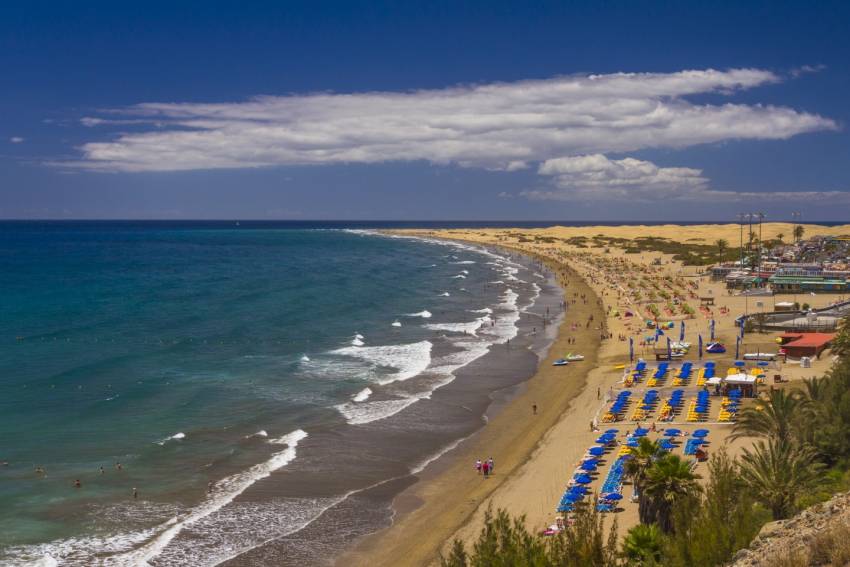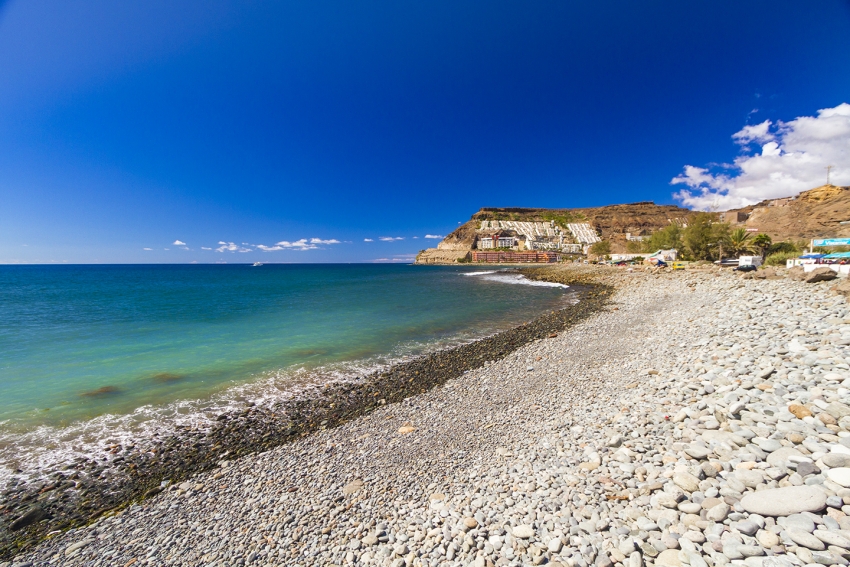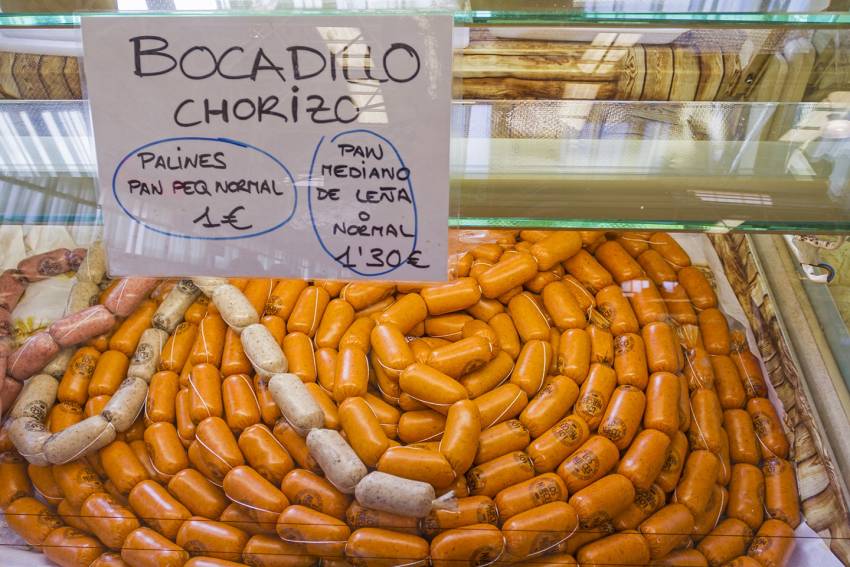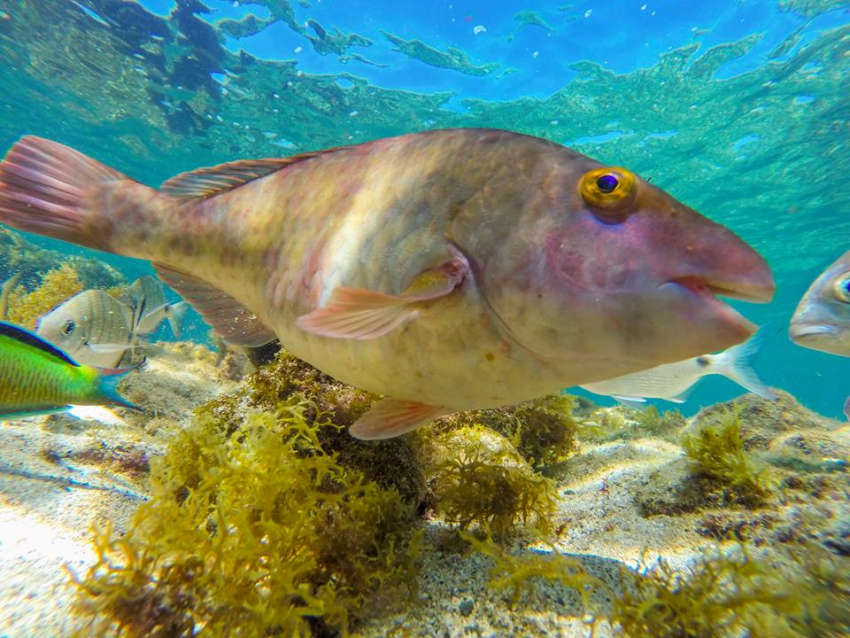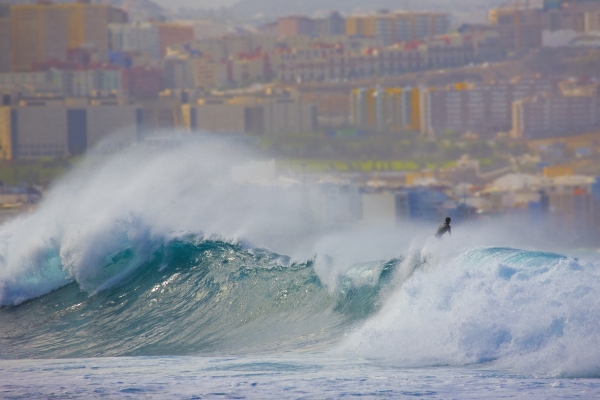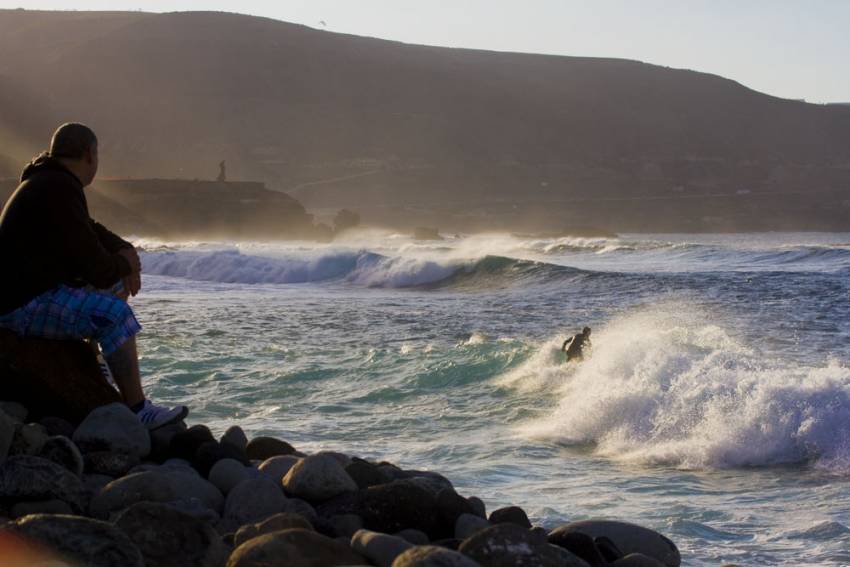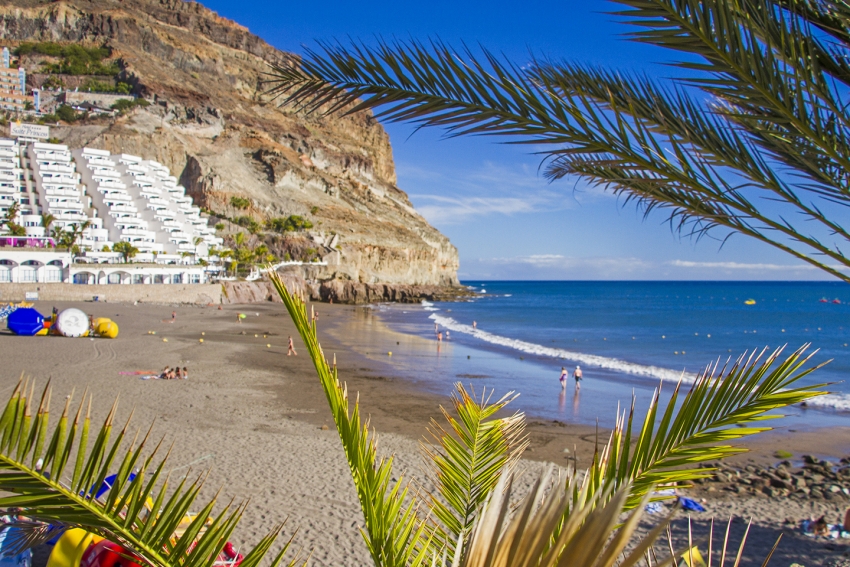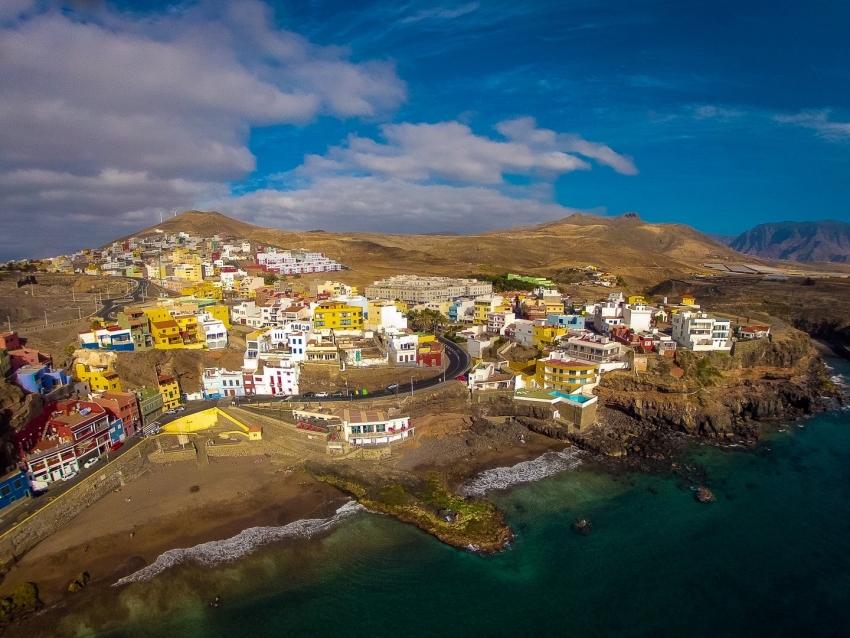Most Playa del Inglés regulars sunbathe, mess about in the sea and eat and drink a lot. They go to bed late, get up late and do it all again the next day. That’s why they love Playa and come back year after year. However, as the island's biggest resort, it's also the base for most activity companies.
While we understand that the sun and fun are one of Playa’s main draws it is a shame to come to an island as beautiful as Gran Canaria and not see anything beyond the resort gates. We encourage everyone to spend at least a day out and about. Many visitors are surprised to discover that Gran Canaria is a huge island with everything from mountains and forests to hidden beaches and pretty villages.
Your reception will have a stack of leaflets full of things to do from Playa del Inglés, ranging from a parachute jump over the dunes to spa days. Just don’t expect to see any elephants during the jeep safaris. And don't go on the free excursions advertised in the leaflets left under rocks all over the resort: They are dodgy.
Gran Canaria has a great bus network and hire cars are cheap and reliable. If you want to see the island without too much effort there are dozens of coach trips that whizz you to the good bits. Just don’t book a free one as they take you to more shops than attractions.
For water sports in the resort, head down to the Annexo II shopping centre and look left.
For shopping, see our guide to Playa's shopping centres and shopping guide
For restaurants, see our guide to eating out in Playa del Inglés
Gran Canaria might not seem like a foodie destination when you're tucking into an all-day breakfast in a shopping centre but plenty of delicious local produce out there. Here's a selection of the best Canarian food and drink to try and buy.
Flor de Guia Cheese
Moist and slightly bitter with a faint taste of grass and old socks: Gran Canaria’s Flor de Guía is the island’s most distinctive cheese. It’s made by traditional methods and protected by an EU Designation of Origin. It is also one of the few cheeses that uses natural vegetable rennet (extracted from thistle or cardoon flowers) rather than animal rennet. This makes it suitable for vegetarians.
Creamy flor de Guia cheese has a soft, yellow rind and is creamy and riddled with small holes. It comes in thin wheels about four inches deep.
You can buy Flor de Guia in the shops but it isn’t the real stuff. Most of the vacuum packed supermarket stuff is media flor made with a mixture or animal and vegetable rennet. It tends to be much denser and dryer than pure flor de Guia. For the genuine article head to the cheese stall at one of the island’s markets. Guia town itself has a tiny Sunday market in front of the church but nearby Galdar’s Thursday market is much bigger.
Agaete Coffee
A small bag of Gran Canaria coffee costs over 15 euros because it is only grown in the mild Agaete Valley. Known as Europe’s only coffee but a more accurate description is the most northerly coffee in the world.
Coffee was first grown in Gran Canaria in 1788 but faded away except in Agaete where the farmers grew if for their own morning cuppa. The bushes grow organically in the shade of mango, papaya and orange trees. Gran Canaria coffee beans are hand picked and sun dried and yield a delicate, fruity coffee with a hint of liquorice. Pretty tasty!
We’ve noticed a lot of coffee bushes lining banana plantations in the hills behind Galdar and Arucas so it won’t be long before the supply increases.
Temisas Olive Oil
Olive trees live a long time and don’t bear grudges. That’s just as well considering that Gran Canaria neglected its groves for over 100 years. The goats ate most of them and the small harvest was pickled ferociously in mojo.
The somebody tested the oil from the gnarled old trees and found that it is first class. Now the olivos are Gran Canaria’s latest way of turning the sunshine into gold.
Farmers are busy learning the skills that their grandparents forgot and new groves go in every year. The best Gran Canaria olive oil comes from the old trees around Temisas, the town with longest history of olive growing in the Canary Islands.
Temisas’ grizzled survivors are old varieties that have died out everywhere else in Spain. Their oil is fruity and herbal with a good peppery kick and a distinctive smell of ripe tomatoes.
Gran Canaria’s olives are harvested by hand and cold pressed. A small bottle costs about 5 euros and is best served on salads or used plain as a dip for fresh bread. It’s too good to wreck with balsamic vinegar so use a white wine vinegar instead.
Fresh Tropical Fruit
The best tropical fruit in Gran Canaria never makes the supermarkets. It’s sold in local markets and village shops. Look out for boxes of fruit that smells fantastic and has fresh green leaves still attached.
Because Gran Canaria is so high we also grow fabulous soft fruit like peaches, apricots, plums, apples and pears. Gran Canaria’s oranges are fantastic, especially the huge navel oranges that ripen during the winter.
Gran Canaria’s bananas are fantastic and taste far better than the Caribbean bananas you get in European supermarkets. It’s because they are a sweet variety and are picked ripe and never refrigerated. Bananas are available all year round.
Gran Canaria’s pineapples are delicious and are available most of the year. Only buy them if you can smell them. Papayas are harder to judge but go for the deepest colour orange or red you can find and leave them to soften for a day or two before eating.
Fresh Fish and Seafood
Most of the fresh fish sold in restaurants in Gran Canaria is farmed seabass (lubina) and gilthead bream (dorada). They are delicious and farmed locally but nothing beats fresh fish caught from the open ocean on the same day as it is cooked. Look out for fresh bonito and tuna and try local favourites like grouper (mero), cabrilla (comber), vieja (parrotfish) and medregal (amberjack).
The trick to finding the best fresh fish in Gran Canaria is to head to the little local restaurants right by the sea. The best have the fish displayed in a cabinet or on a dish by the entrance. Look for fish that is shiny with clear, glossy eyes. If the eyes are opaque or sunken you are looking at old or defrosted fish.
Squid freezes well so it doesn’t have to be fresh
Almogrote
La Gomera’s answer to pesto, almogrote is a tasty spread made from cured goat cheese, garlic, chili and olive oil. It’s traditionally served on pan bizcochado (crispy double-baked bread).
Almogrote is delicious but make sure you all eat it together as it’s full of garlic. You can buy glass pots of almogrote in most Gran Canaria supermarkets: Try and find one that is made in La Gomera rather than in Gran Canaria or Tenerife: It’s just fairer.
Guarapo
Guarapo or palm honey is another Canarian delicacy from la Gomera: It’s our equivalent of maple syrup and is fantastic on pancakes.
Guarapo is made from sap extracted by hand from La Gomera’s many palm trees. Each tree can only be tapped once every seven years: Someone climbs up each tree and cuts into the bud. The sap drains out and is boiled down into a thick, dark syrup.
La Gomera’s palm honey harvest is a fantastic and sustainable local industry that guarantees the future of the islands palm trees. Taking a bottle home helps support the Gomeran’s traditional way of life.
Supermarkets sell bottles of guarapo for about seven euros. Don’t confuse it with miel de caña or cane syrup as this is imported and nowhere near as tasty.
La Palma Salt
Sea salt from Fuencaliente in the far south of La Palma comesa from outdoor salt pans and is made by traditional methods. The best is called flor de sal which is light, fluffy scales of salt rather than big grains. It's highly rated by top chefs for its clean taste and purity. Look out for the purple packs of flor de sal flavoured with local red wine: Perfect for seasoning stews and grilled meat.
Wine
Canarian wine is so good that we've given it it's own section. While Lanzarote's whites and Tenerife's red are the easiest to find in the superamrkets it's worth tracking down Gran Canaria's white wines as they get better every year. Click here to visit our wine section.
Tauro beach is Gran Canaria's lazy Sunday chill-out beach for people old enough to remember the resorts going up. They gather at weekends to listen to proper music and drink the island dry. With a long pebble beach, several ramshackle bars and a motely colection of decaying houses, Tauro is the anti-Amadores. For now!
The best time to visit Gran Canaria, without a doubt, is now. However, here's what to expect at any time during the year.
There’s no bad month to visit Las Palmas city as its climate is one of the world’s best, but the weather does have its quirks. Here’s a season-by-season guide to the weather in Gran Canaria’s capital.
Gran Canaria's North Shore, sandwiched between the breakers and the banana plantations is riddled with authentic seafood restaurants. Ignore the roadside warehouse restaurants between Bañaderos and San Felipe and head for these tried-and-tested spots instead.
Puerto de las Nieves
Puerto de las Nieves in the far north west of Gran Canaria caters to mobs of seafood-hungry Las Palmas locals at weekends. You won’t get a table at the beachfront restaurants after 13.30.
Visit during the week and Puerto de las Nieves reverts back to its natural, peaceful state. The odd carload of intrepid tourists that have driven from Las Palmas or along the West Coast road are often the only people on the terraces.
Puerto de las Nieves shuts up shop during the evenings. Most restaurants close but you’ll always find somewhere to knock out a plate of calamares.
Top Picks
El Dedo de Dios restaurant is the only one to the left of the old jetty. While it doesn’t have outdoor seating you can sit by the big windows if you arrive early. The food excellent and the best value in town. The Dedo opens at night.
The quintessential Puerto de las Nieves seafood restaurant with a whitewashed terrace right by the beach and fishing nets on the walls. The seafood is good and the slight premium you pay is worthwhile if you can get an outside table.
Sardina del Norte
This tiny fishing harbour clings improbably to the narrow platform at the base of a high sea cliff in north west Gran Canaria. It’s a popular local spot because of its sandy beach, value restaurants and top-notch dive spots
The beach is small and sometimes gets washed away in winter but is the only sandy beach along the north coast. It has toilets, showers and sunbathing platforms.
Sardina’s restaurants serve seafood and Canarian dishes and their prices are local.
Top Picks
Right by the diving jetty the ramshackle El Ancla restaurant does great seafood, serving it without a trace of irony to divers just out of the ocean. The seafood and vegetable fry up is superb.
Embedded in the cliff overlooking the beach Mama Lolilla has to be one of Gran Canaria’s Top Location Restaurants. Arrive early (before 13.30) and you get the one-table terrace with the best view.
La Puntilla
Las Canteras beach ends at La Puntilla but the walkway continues all the way to El Confital beach two kilometres north. It’s a much quieter part of the city with residential streets and little rocky bays.
The restaurants here are local and serve seafood at lower prices than along the beachfront.
Amigo Camillo is first restaurant on the front as you walk north from the big square at the north end of the beach. It's right on the edge of the rocks with greats views from its covered terrace. The calamares and puntitas (deep-fried baby squid) are delicious and there’s always fresh fish on display.
Las Coloradas
The most northerly village in Las Palmas is tucked away in the La Isleta Peninsula and surrounded by a military base.
Las Coloradas isn’t by the sea and its restaurants don’t have a great view. However, its been a city hotspot for seafood for decades and after a lull is coming back onto the radar.
The Mirador del Atlante
Drive west out of Las Palmas along the coast road and you soon get to Tony Gallardo's amorphous but feminine sculpture. It represents the legend of Atlantis and looks like a giant woman facing the ocean.
Just past the sculpture is the Mirador del Atlante outdoor restaurant serving seafood and local dishes. It’s the only decent restaurant along the north coast with a good view of the city although you do pay for the location.
To reach the Mirador as you come into Las Palmas you have to drive past and turn around in the city: Just take the first exit past the bridge and use the roundabout by the Las Arenas shopping centre.
El Roque
Every house in colourful El Roque village sits on a huge rock sticking out into the ocean in north Gran Canaria. Perched right at the tip is the Italian run Locando El Roque. It does a range of pasta and fresh fish and while it's more upmarket than most seafood places in north Gran Canaria, its location is exceptional.
Puertillo
The only sandy beach along the Gran Canaria North Shore, El Puertillo has a couple of fantastic local seafood spots right by the sand. There's not much to choose between them and they fill up fast at weekends.
There’s a faint odour of garlic in most of Gran Canaria’s little shops and it comes from the string of vivid orange sausages next to the cheese.
Chorizo de Teror is the Canarian version of Spanish sobreasada but is rammed with garlic. It’s basically a thick pate in a sausage skin and is served spread on crusty bread. Canarians eat it at any time but it’s popular as a breakfast snack during fiestas.
Be warned: Chorizo de Teror is a breath monster of a snack and we don’t advise eating it the day before you fly home.
The Terror in Teror
For the island’s most authentic and potent chorizo head to Teror town on a Sunday and buy one in the market along with a fresh bread roll. Just squeeze out the contents into the halved roll and spread with the skin. Then tuck in.
We guarantee that the locals will stop and watch you. They love their Chorizo de Teror but very few tourists are brave enough to try it.
Alex says: Dial down the garlic by cooking chorizo de Teror: Put it in a bowl with about an inch of a strong spirit such as vodka or aguardiente (local firewater made from the remnants of grape pressings). Light the alcohol and the heat shrinks back the sausage skin and melts away some of the fat. Wait until all the booze has burned off and help yourself. You’ll still stink of garlic the next day but the flavour mellows with the heat.
Chorizo de Teror is an authentic Canarian treat but you never get it in hotels or in tourist restaurants: The taste is just too strong for most visitors. If you are inspired to give it a go please let us know what you think of it.
Millions of people come to Gran Canaria every year for its beautiful beaches and perfect weather. Some of you however, want to do a bit more than just get a tan. If you fancy going for a walk in Gran Canaria, but don't want to go too far from the resorts, don't worry: There are plenty of excellent walks right in the heart of Gran Canaria's main resorts.
Walking in Gran Canaria ranges from sunset strolls by the sea to epic treks across the mountains. Here’s our guide to the resort walks in Gran Canaria that combine easy walking with plenty of outdoor cafes and ocean views.
Across the Maspalomas Dunes
The dunes are Europe's only slice of the Sahara Desert. They stretch over 6km from Maspalomas resort to Playa del Ingles. The best way to see them is to walk right across them from the end of Avenida Tirajana to the sea.
See here for a Google Map of the start point for this walk.
The walk takes an hour with a couple of stops for taking photos and running up and down sand dunes. The soft sand is hard going so stick to the crests of the dunes for the easiest path. Take water, a hat and sunscreen.
Once you reach the sea either walk west along the beach back to Maspalomas or east back to Playa del Inglés. We recommend doing the walk at dawn or dusk as you will get better photographs and it won't be as hot.
Beach walking from Maspalomas to Playa del Inglés
If walking through the dunes sounds like too much hard work, then walk along the shore from Maspalomas to Playa del Inglés resorts, or vice versa.
Start either in Maspalomas by the lagoon, or from the Annexo 2 line of restaurants on the beach in Playa del Inglés. The walk is about 6 km long and takes a couple of hours with a stop for a swim, some sunbathing, or a drink at one of the many snack stands on the beach.
You’ll go past the nudist sections of the beach so don't be surprised if you see a few naked people splashing about in the sea or playing volleyball on the beach (what is it with nudists and volleyball?).
The Costa Canaria Walk
You don't even have to get sand in your sandals to walk along the beachfront in Playa del Ingles. The beachfront promenade, called the Paseo Costa Canaria, runs all the way from the end of Avenida Tirajana to San Agustín Beach about 5km east. The whole walk is dune- or seafront and takes you past a couple of quiet, local beaches.
Walking from Playa del Inglés the promenade, which is largely wheelchair friendly, runs behind the dunes and past the three small, sheltered beaches called Playa El Cochino at the end of Playa del Ingles beach.
The walkway continues along the coast to Las Burras Beach with its golden sand and largely local crowd and goes on all the way to San Agustin Beach and up the hill to the end of San Agustín Resort. The whole walk takes a couple of hours one way if you include a drinks stop or a swim at one of the beaches.
Meloneras Promenade
The Lugar las Meloneras seafront promenade is in the newest and most upmarket part of Gran Canaria's resorts. It runs between the historic Maspalomas lighthouse, soon to open as a museum and exhibition centre, all the way to Meloneras Beach. The walk takes you past plenty of shops, bars and restaurants, and past a tiny archaeological park right on the seashore.
Lugar las Meloneras is a great place to walk in the evening as you get to watch the sea set over the Atlantic Ocean. Meloneras Beach itself gets ignored by most visitors in favour of bigger Maspalomas Beach. It is sandy and has its own little shopping centre with bars and restaurants. If Maspalomas beach is windy, there is a good chance that Meloneras will sheltered enough to sunbathe.
From Puerto Rico to Amadores Beach
The safe, cliff-top walk from Puerto Rico resort to Amadores Beach gives you beautiful views of the turquoise sea and rocky shore along the way. There is even a spiral stair case in front of the Gloria Palace Hotel that takes you down to the sea. If the sea is rough, which isn't that often, don't go down the staircase as people have been washed off the rocks during storms.
The walk starts from the shopping centre in Puerto Chico. It takes about 40 minutes one way. Once you get to Amadores Beach you can get a drink or a snack in one of the restaurants, go for a swim and do a spot of sunbathing, and then either walk or take a taxi or bus back to Puerto Rico.
These walks may not take you up into rugged Gran Canaria mountains, or past any rural villages but they give you amazing views of the sea and have plenty of convenient drink stops.
One of the open secrets of Gran Canaria is the high quality of the Scuba Diving.
The fast, barrelling, right-handed point break at El Confital is one of Europe's top bodyboarding waves and hosts European tour events regularly.
Gran Canaria Info recommends:
- Default
- Title
- Date
- Random

